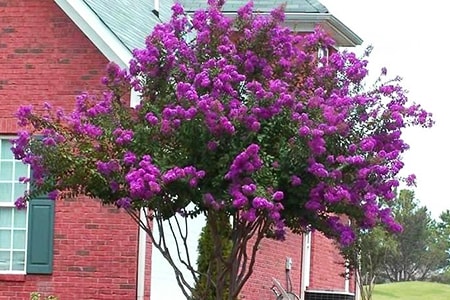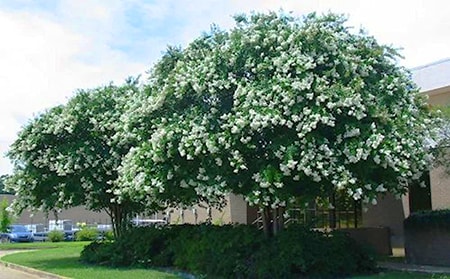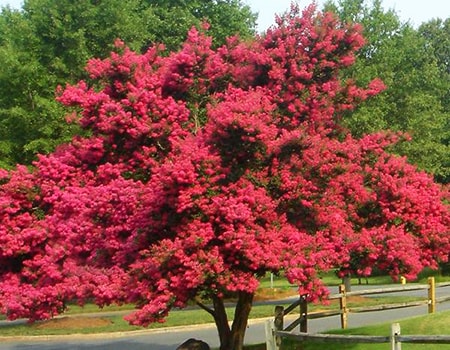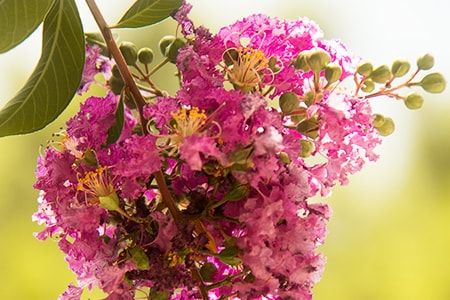How to Prune Crepe Myrtle to Boost Health, Growth, & Looks
Author: Jen Worst | Editor: Omar Alonso
Review & Research: Jen Worst & Chris Miller

Pruning crepe myrtle is easy but it can't be done carelessly. You can't just go at it if you want it done right. Learning how to prune crepe myrtle, thankfully, is very simple, and that's what I'll be sharing with you now.
Crepe myrtles are an evergreen tree, so they have beauty to share all year round, bringing color to your garden and making it look lively. They're known to be a symbol of happiness and wellness for families in many cultures.
They're hardy plants, and even with little care the flowers grow generously. In the fall season, the leaves turn many shades of an exciting color. In the spring and summer, you can have bright red, pink, purple, lavender, or white colors depending on the type you've planted.
These trees are so popular because they require little care, but the flowering occurs in huge numbers. However, that doesn't mean you can just ignore them, because they will need pruning unless you want them to get unruly and possibly unhealthy.
We know how people get intimidated by even the idea of pruning trees and bushes. There's always a fear that they'll mess it up somehow.
But think about the bigger picture. Pruning your crepe myrtle will encourage more growth, the carefully crafted shape of the tree or bush will remain intact, and it'll become stronger and healthier. Let's jump right into it.
When to Prune Crepe Myrtle

When your crepe myrtle or any types of myrtle are about to break out of its dormancy stage, right in the early spring, that's the best time to prune them. You'll hear about people pruning theirs during fall, but experience suggests that's not ideal.
During winter, when the plants need the protection the most, if you remove the protective layer of leaves growing on and around them via pruning during the fall, your plant may be overly stressed and exposed during lower temperatures.
Whether you do it in the late winter or early spring, the main point is that you want to prune right before the new growth starts to take off. Look for the earliest indicators and when you see them, go ahead and take care of this important task.
How to Prune Crepe Myrtle

One of the crucial tasks in pruning crepe myrtle is to get rid of all the unnecessary branches (or trunks, as they'll become) that develop over time that cause the tree or bush to be too dense and voluminous in size. Taking care of this means you'll have far less work to do when pruning new growth. Here is how you do it.
1. Choose a Good Framework
As we said, crepe myrtles are known to develop multiple trunks. Pruning makes sure the desired trunks are receiving their needed space and air circulation.
There's nothing overly methodical about this. It's really more of an art than a science. Prune the ones that aren't pretty. If they're twisted, bent, and gnarled then they've got to go!
Try not to cause the tree to become lop-sided in appearance though. Pick ones that thin out the density evenly all around, including on top and not just the sides.
2. Always Start Near the Soil
Cut any sucker or unnecessary trunk you see that's coming out of the soil. A sucker is a branch that is grafted onto the roots beneath the union bulb that's seated atop the soil.
These branches soon become trunks of seemingly independent bushes or trees, except they're connected to the same root system. This places a lot of demand not only on the roots but the soil too.
Make sure you cut the suckers extremely close to the ground, if not slightly below the soil. By doing this, you'll avoid facing additional problems with pests or diseases.
It also avoids leaving you with any unsightly partial branches sticking out of the ground that can't survive. Dead parts of a tree should always get eliminated, first thing, making sure not to leave the debris around which can harbor diseases or attract destructive insects.
3. Prune the Bottom Branches

If your crepe myrtle is growing in a place where there is a pathway for people or cars, cut the bottom branches off as close to the trunk as you can. The point is to lift the tree up so the lowest branches are even higher by virtue of removing those below them.
It's best to lift them to at least 8 to 10 feet above the ground. This gives pedestrians and vehicles enough room to pass underneath without incident.
While you're at it, look for any low branches that fall under the three D's:
- Dead
- Dying
- Diseased
Get all of these gone and hauled off away from the ground around the tree too. This will help clear out some space since you need to move your way further up and into the tree.
4. Pruning the Crown
After getting done with the extra trunks and bottom branches, you can start with pruning for the crown. The crown is the main bulk of a tree or shrub with all of the flowering branches and limbs.
The ideal look for our crepe myrtle is a thinned out crown as far as the main limbs are concerned. They look lovely once they bloom if their branches spread out in different directions without crowding each other. Otherwise you end up with a dense mess.
While cutting the unwanted branches away, make sure you cut close to the bud, and the angle should be slightly in the direction you want your branch to go in. It will follow the path of the angle of the cut, so you can direct it however you please.
You should also get rid of any crossover branches, as they become a problem in high winds, possibly breaking each other. Prune your crepe myrtle from inside; it will increase ventilation and protect it from diseases like powdery mildew.
5. Trim Away Weak & Thin Branches
Now comes the final part. Cut away all of the tiny and thin branches. These are so frail and weak that they'll either become damaged or attempt to mature, and pull away energy and nutrients needed for flowering later.
Why You Shouldn't Cut Your Crepe Myrtle to 3 Feet Tall

People cut their crepe myrtle bushes short every year, which isn't a good thing. They're hardy plants that can endure any pruning you hit them with, but to thrive they shouldn't be disrupted this severely. Here are a few things that are a result of your bad pruning.
Creates Bad Branches
Pruning your bushes every year to 3 or 4 feet is way less than ideal for the health of the branches. As we know, pruning will encourage faster growth, but the branches are too weak and thin for the big flowers that grow on the plant early.
These weak branches will get in the way and may become a nuisance when they fall upon things, people, and property. The bush or tree spends too much energy trying to heal from the trauma you've created too, causing a weak and unsightly blossoming period.
Causes Less Blooming
When you cut your tree every year, and far too short, you're also encouraging more foliage growth. This is due to each branch now essentially becoming a relative trunk in size and due to the natural reaction of the plant trying to receive more energy from the sun to heal.
Spending this much energy in leaf production means the plant doesn't feel ready to blossom as much, which basically defeats the purpose of having these trees and bushes in the first place.
You'll Miss Out on Pretty Barks
Some of the varieties of crepe myrtle have colorful barks which peel as they mature. If you do excessive pruning, you'll rob yourself of this extra beauty, too.
In short, don't do what everybody else is doing by cutting them too short, almost like stubs. These aren't meant to be tiny shrubs. It affects their future growth in unintended ways that you may not anticipate.
Importance of Pruning Crepe Myrtles

Pruning is an integral part of caring and growing any plant. Crepe Myrtles don't require pruning necessarily, but with pruning, they can grow so much more efficiently and beautifully.
The benefits of pruning crepe myrtles are endless. It's not a tricky task. In fact, it's rather easy. Here are some importance reasons to take care of this fun chore.
For Health Reasons
Pruning means eliminating all the dead, diseased, and wilting stems, stubs, flowers, and branches. By doing this, you're making sure that your garden is protected along with your plants.
Pruning helps plants grow in good shape both physically and in regards to health, and it gives off a lot more flowers than usual.
By eliminating any dead or diseased plant, you are also removing all kinds of pests and insects that may be attracted to them.
Keep the Size Under Control
If you prune your crepe myrtle regularly, you'll see how much easier it becomes each year and how they don't get out of control visually. Often with no pruning, some plants become a headache due to their wild growth.
You can control this using the methods in this guide. It improves the overall aesthetic of your garden because nobody likes to see dead plants, leaves, and flowers hanging around or spawning off in wild directions.
Protection From Disease & Pests
Stems and branches that are dead and loose can become a problem when there's a storm or any other calamity. To keep your family and house protected, always keep your trees in shape.
It will also help you with pests and diseases by compromising their habitats, which will discourage them from even nesting within or around your tree or bush. Aphids and scales are found on crepe myrtle and are best taken care of by using herbicides.
That's How to Prune Crepe Myrtle!
We encourage shaping your trees and bushes in these specific ways to ensure their healthy growth without compromising on their attractiveness. They'll make your garden look incredible, with the right pruning. Now you know how to prune crepe myrtle. Go forth and prosper!



